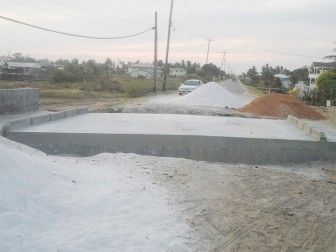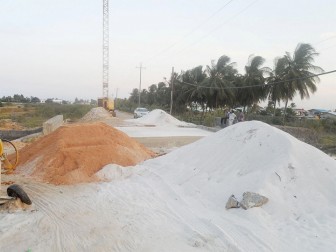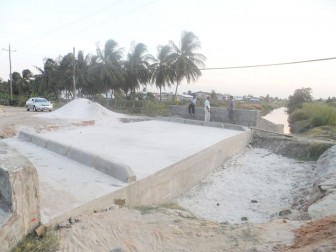Residents of Foulis, East Coast Demerara, are hoping that the reconstruction of a community bridge along the embankment road will be completed soon, bringing an end to their continuing traffic woes.
According to residents, issues with the bridge began earlier this year when they noticed that a small “pothole” had developed at the left side of the bridge. As time went on and vehicles continued to traverse the bridge, the unrepaired hole got wider and deeper until eventually its width encompassed almost half of the entire bridge.

“When this happened, vehicles heading in opposite directions could no longer traverse the bridge simultaneously,” said one villager. Vehicles on one side had to stop and wait for vehicles coming from the opposite direction to pass before they could cross themselves. Villagers said that this would lead to a substantial build up of traffic, especially around peak hours in the morning and afternoon.
Another villager said that the bridge remained in this state over a period of months before any measures to fix it were taken. In addition to the first hole, a second, smaller hole developed on the other side of the road, further complicating the traffic situation.
Residents related that a contracting company was eventually hired to repair the bridge. They stated that the company used a material, described as ‘thinning,’ to fill the holes. This allowed vehicles going in both directions to traverse the bridge simultaneously.

This solution, however, was short-lived, since “every time the rain fall the material would be eroded,” causing the hole to reemerge. One resident, who lives very close to the bridge, recalled an incident where a “car moving at a very fast pace flew over a speed bump situated right before the bridge and landed in the hole which, because of heavy rainfall that day was filled with water.” She related that the driver of the vehicle was unable to help himself immediately and could have drowned “because the water was so high in the hole.”
Desma Pitt, a resident of the village, stated that the contracting company subsequently decided to remake the entire structure out of concrete. Pitt admitted that she welcomed the decision to use concrete for the reconstruction, but that she would not be entirely pleased until the bridge was completed.
Pitt operates a small bar a few feet from the bridge and is dependent on the flow of people to support her business. However, since the bridge has not yet been fully reconstructed, she claims that she is losing business because not as many people are able to traverse this part section of the railway embankment.

Cars are unable to cross the bridge because two ditches have been dug on either side of the bridge; it is unclear why the ditches were dug. It is, however, clear that it restricts any kind of vehicular traffic from using the structure. Some daring motorists have opted to place wooden planks across both ditches and carefully manoeuvre their bikes across. In addition to this, Pitt stated that part of her front fence, as well as an outside toilet placed in her yard for use by patrons, were torn down to facilitate works on the bridge. “I hope that these people plan to build back my fence and the toilet when they finished,” stated a concerned Pitt.
Works on the bridge are at a standstill because “the contractors say that the structure has to be allowed to cure before any further works can be done on it.” In the meantime, residents and passersby do their best to get to and from their destinations. Efforts to contact the contracting company responsible for this project were unsuccessful.





